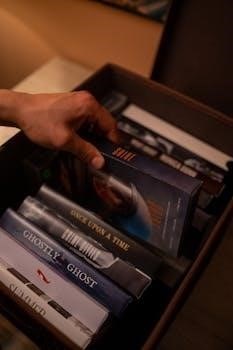
Overview of “Better Than the Movies”
Lynn Painter’s “Better Than the Movies” is a young adult romantic comedy centered on Liz Buxbaum‚ a teen obsessed with rom-coms. She sees her life through the lens of these films‚ seeking her own happily-ever-after. The story includes classic tropes like fake dating and enemies-to-lovers.
General Plot and Themes
The novel follows Liz Buxbaum‚ a high school senior navigating life and love with a romantic comedy-tinted perspective. Grieving her mother’s death‚ she seeks a movie-worthy romance‚ particularly with her childhood crush‚ Michael. When he returns‚ she enlists her next-door-neighbor‚ Wes‚ in a fake-dating scheme to make Michael jealous. This leads to an unexpected connection with Wes as she is slowly discovering that the real life love may be better than the movies. The novel explores themes of grief‚ healing‚ the challenges of growing up‚ the difference between fantasy and reality‚ and the search for genuine love and happiness. It combines humor with heartfelt moments‚ highlighting the importance of being true to oneself.
Character Analysis
This section will delve into the characters of “Better Than the Movies‚” particularly focusing on Liz Buxbaum’s development. We’ll also examine the roles and impacts of supporting characters‚ as well as their relationships.
Liz Buxbaum’s Character
Liz Buxbaum is portrayed as a seventeen-year-old‚ hopeless romantic who views life through the lens of classic romantic comedies. She’s quirky‚ funny‚ and sweet‚ but also deals with grief over her mother’s passing. Liz’s behavior‚ sometimes deemed “weird‚” is often justified by her emotional state and the situations she finds herself in. She is highly relatable‚ with her insecurities and hopes for a “happily ever after” resonating with readers. Her devotion to rom-coms shapes her expectations of romance‚ leading her on a journey of self-discovery. Liz seeks authentic connections while navigating the messy realities of life and love.
Supporting Characters and Relationships
The novel features a range of supporting characters‚ including Wes‚ the boy next door‚ with whom Liz has an initial “enemies” dynamic. Their relationship evolves through a fake-dating plot‚ showcasing their growing connection. There’s also the childhood crush‚ who serves as the catalyst for Liz’s romantic pursuits. The story also focuses on the importance of family and friendships‚ highlighting the support system Liz relies on. These characters contribute to Liz’s personal growth as she navigates her feelings and relationships‚ and make the whole novel a better experience. They make her path to love a sweet and funny one.

Rom-Com Tropes and References
The book heavily utilizes rom-com cliches‚ such as makeovers and fake dating‚ which are central to the plot. It also pays homage to classic romantic comedies‚ incorporating references that add to its charm.
Use of Rom-Com Cliches
The narrative of “Better Than the Movies” is built upon numerous well-established romantic comedy tropes‚ creating a familiar and comforting reading experience for fans of the genre. The story prominently features the “fake dating” trope‚ where Liz and Wes pretend to be a couple‚ which leads to unexpected romantic developments. Another key cliche is the “enemies-to-lovers” dynamic‚ as Liz and Wes start off with a contentious relationship before realizing their feelings. Additionally‚ the story includes a classic makeover scene‚ as Liz tries to transform her appearance to attract her crush. These familiar tropes contribute to the lighthearted and enjoyable nature of the book‚ ensuring that readers recognize and appreciate the playful‚ predictable elements of a classic rom-com.
Homage to Classic Romantic Comedies
“Better Than the Movies” is a clear homage to classic romantic comedies‚ with numerous references and allusions woven throughout the narrative. Liz’s character is deeply influenced by the rom-coms she’s grown up watching‚ which shapes her perception of love and relationships. The book features direct mentions of specific films‚ allowing readers to recognize and appreciate the nods to beloved movies. This creates a sense of nostalgia for those familiar with the genre. The plot itself mirrors the structures and storylines found in many classic rom-coms‚ and the characters often act in ways that reflect these cinematic influences‚ creating a meta-narrative that celebrates the genre’s enduring appeal.

Reception and Reviews
“Better Than the Movies” has received positive feedback from readers‚ with many praising its charming and sweet nature. It’s often described as a heartwarming and refreshing contemporary romance‚ appealing to fans of the genre.
Reader Feedback and Reactions
Readers have largely embraced “Better Than the Movies‚” frequently citing its endearing characters and relatable situations. Many found Liz Buxbaum to be an adorable and relatable protagonist‚ despite some of her quirky behavior‚ which they often attributed to her grief and circumstances. The book’s incorporation of classic rom-com tropes resonated well‚ creating a fun and engaging reading experience; Some readers were particularly moved by the themes of grief and forgiveness woven into the romantic narrative. The book is often recommended for those who enjoy lighthearted‚ contemporary romances with a touch of humor. Overall‚ the feedback suggests a strong connection between the book and its audience.
Critical Acclaim and Popularity
“Better Than the Movies” has garnered significant positive attention‚ solidifying its place as a popular YA romance. The novel is frequently praised for its charming and heartwarming narrative‚ appealing to a wide audience seeking feel-good stories. Critics have noted its successful blend of humor‚ romance‚ and emotional depth‚ creating a well-rounded reading experience. The book’s clever use of romantic comedy clichés‚ combined with fresh perspectives‚ has been a point of acclaim. It is also recognized for its tribute to classic rom-coms while delivering a modern story‚ thereby enhancing its appeal. The book has established itself as a go-to recommendation within the romance genre‚ indicating its critical success and popular reach.

Author and Style
Lynn Painter is known for writing romantic comedies for both teens and adults. Her style often includes humor‚ pop culture references‚ and heartfelt moments. She is praised for creating relatable characters and engaging plots;
Lynn Painter’s Writing Style
Lynn Painter’s writing style in “Better Than the Movies” is characterized by its lighthearted and humorous tone‚ which makes the novel easy and enjoyable to read. Her use of witty dialogue and relatable teenage angst creates an authentic voice for her characters‚ particularly Liz Buxbaum. Painter’s narrative incorporates plenty of pop-culture references‚ especially to classic romantic comedies‚ which adds another layer of charm for readers who are familiar with the genre. The author also seamlessly blends comedic moments with genuine emotional depth‚ allowing her to explore themes of grief and self-discovery with sensitivity and grace. Her writing is engaging‚ and accessible‚ making the novel a perfect choice for fans of contemporary YA romance.
Target Audience and Genre
“Better Than the Movies” is primarily aimed at young adult (YA) readers‚ particularly those who enjoy contemporary romance novels. The book’s themes of first love‚ high school experiences‚ and self-discovery resonate strongly with a teenage audience. As a romantic comedy‚ the novel blends humor with heartfelt moments‚ making it an appealing choice for fans of the genre. The inclusion of classic rom-com references adds an extra layer of enjoyment for readers who are familiar with those movies. While the main focus is on the romance‚ the story also deals with themes like grief and family‚ broadening its appeal to readers interested in emotional depth within a lighter context. The book offers a fun and engaging reading experience for young adults looking for a light and heartwarming read.

Adaptations and Comparisons
While “Better Than the Movies” is primarily a novel‚ discussions often compare it to classic rom-com films. The book’s themes and tropes are analyzed alongside popular movie adaptations‚ creating an interesting dialogue about both mediums.
Book vs Movie Comparison
Currently‚ there isn’t a movie adaptation of “Better Than the Movies‚” so direct comparisons are not possible. However‚ the book’s narrative is structured with a cinematic feel‚ drawing heavy inspiration from romantic comedy films. Readers often imagine how certain scenes would play out on screen‚ considering elements like casting and visual style. Some minor character differences‚ such as Stephanie being a vlogger in a hypothetical movie versus a blogger in the book‚ are discussed to highlight the potential changes in adaptation. The book’s heavy reliance on rom-com tropes also lends itself to such comparisons.
Discussion of Movie Adaptations in General
The discussion of movie adaptations often revolves around the question of whether the film stays true to the source material. Adaptations can streamline novels by removing lengthy exposition‚ sometimes making the story more accessible. However‚ changes in the adaptation process can lead to fan disappointment‚ especially if beloved characters or plot points are altered. Some movie adaptations enhance the source material by utilizing the visual medium effectively‚ while others fail to capture the essence of the book. This debate highlights the challenges in translating literature to the screen‚ affecting both fans and critics.
Leave a Reply
You must be logged in to post a comment.